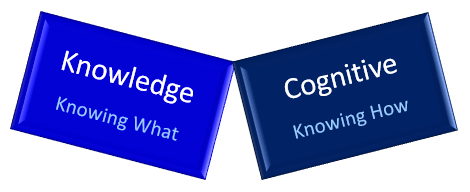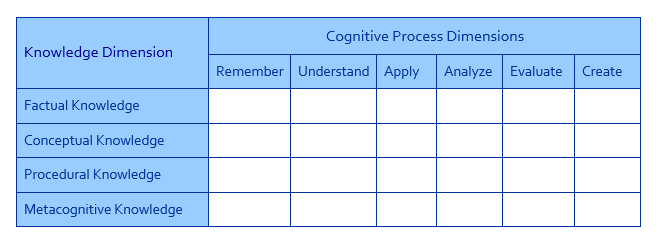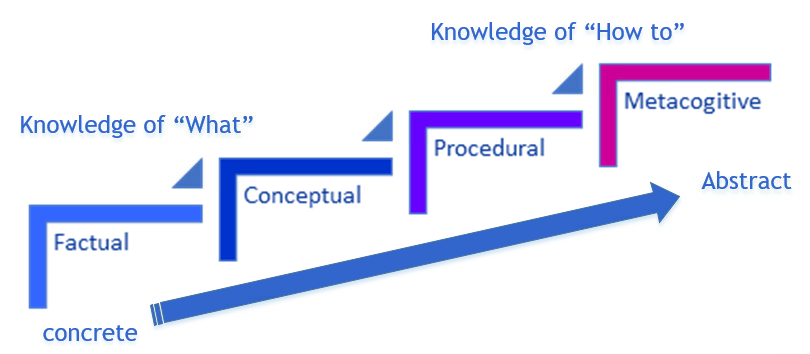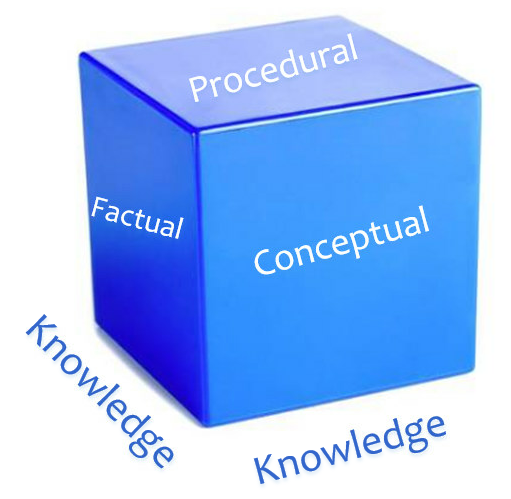Blooms Taxonomy
In 1956, Benjamin Bloom published a classification system for categorizing cognitive skills and learning behavior known as Bloom’s Taxonomy. The classification begins at the basic level which is simple recall skills and progresses to the perceived highest level of cognitive processing. The Taxonomy defines six different levels as Knowledge, Comprehension, Application, Analysis, Synthesis, and Evaluation.
Blooms Taxonomy Revised
In 2001, a group of cognitive psychologists published a revision of Bloom’s Taxonomy. The group revised the taxonomy using verbs to label their categories rather than the nouns of the original taxonomy. These verbs describe the cognitive processes by which thinkers encounter and work with knowledge.
This revised taxonomy is a two-dimensional framework for identifying and categorizing learning outcomes with a cognitive emphasis. This version differentiates between the “knowledge” category and the other 5 levels of Bloom’s model. The other levels dealt with intellectual abilities and skills in relation to interactions with types of knowledge. They separated this out because they believe there is a significant difference between knowledge and the mental and intellectual operations performed on, or with, that knowledge. This separation identifies and creates two dimensions; Knowledge and Cognitive Processing.

Knowledge Dimensions and Cognitive Dimensions
The new taxonomy differentiates between “knowing what,” the content of thinking, and “knowing how,” the procedures used in solving problems.
The Knowledge Dimension is the “knowing what.” It has four categories: factual, conceptual, procedural, and metacognitive.
The Cognitive Process Dimension is the “knowing how.” This revised version like the original has six skills. They are, from simplest to most complex: remember, understand, apply, analyze, evaluate, and create.

About the Knowledge and Cognitive Dimensions
The Cognitive Process Dimension
The cognitive process dimension represents a continuum of cognitive complexity. The dimension contains six categories of thinking skills. The categories are on a continuum of increasing cognitive complexity, from lower order thinking skills to higher order thinking skills.
Cognitive Processes Levels
Remember – Retrieve relevant knowledge from long-term memory.
Understand – Construct meaning from instructional messages, including oral, written and graphic communication.
Apply – Carry out or use a procedure in a given situation.
Analyze – Break material into foundational parts and determine how parts relate to one another and the overall structure or purpose.
Evaluate – Make judgments based on criteria and standards.
Create – Put elements together to form a coherent whole, or reorganize elements into a new pattern or structure.
Knowledge Dimension
The knowledge dimension contains four categories on a continuum of concrete knowledge to abstract knowledge. These four types of knowledge help determine what to teach and how to teach it, or instructional content and instructional methods and activities.
Levels of Knowledge
Factual Knowledge – The basic elements learners must know to be acquainted with a discipline or solve problems.
Conceptual Knowledge – The interrelationships among the basic elements within a larger structure that enable them to function together.
Procedural Knowledge – How to do something, methods of inquiry, and criteria for using skills, algorithms, techniques, and methods.
Metacognitive Knowledge – Knowledge of cognition in general, as well as awareness and knowledge of one’s own cognition.


Reference
Bloom, B. S. (1956). Taxonomy of Educational Objectives: The Classification of Educational Goals. Handbook 1; Cognitive Domain.
Krathwohl, D. R. (2002). “A Revision of Bloom’s Taxonomy: An Overview.” Theory into Practice
